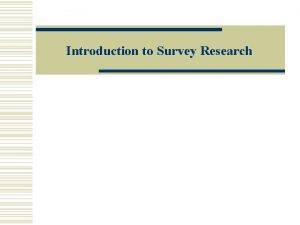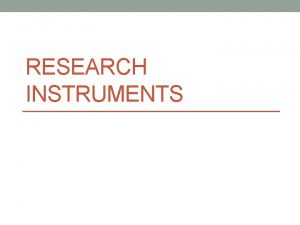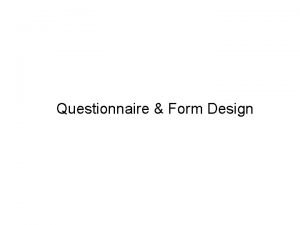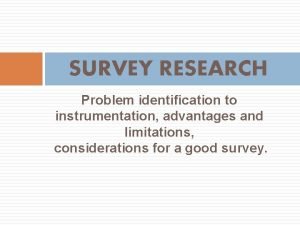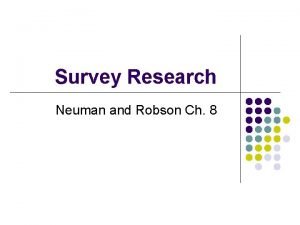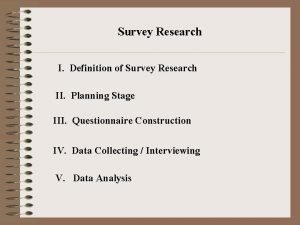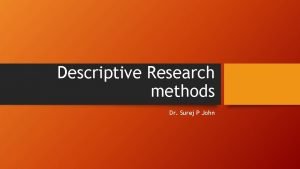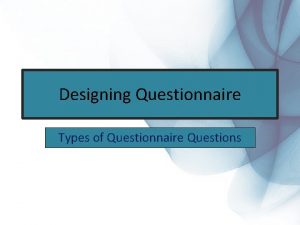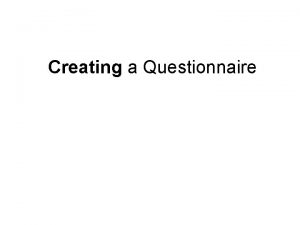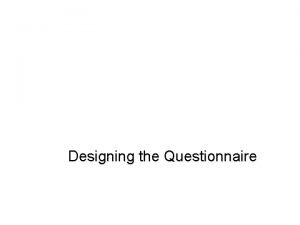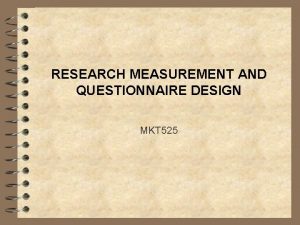Quantitative Research Contents Quantitative research Questionnaire survey steps

















- Slides: 17

Quantitative Research

Contents Quantitative research Questionnaire survey – steps Questionnaire – advantages/disadvantages Type of questions Scaling responses Question placement

Quantitative Research Typically involves counting or measuring Often statistical tests are applied to detect or confirm trends Purpose is to get clear-cut, precise and accurate results, factually reflecting the situation under study Questionnaire is one of the popular tools for the quantitative research

Questionnaire Survey - Steps 1. 2. 3. 4. 5. 6. 7. Define the problem/ survey topic Use previous studies & expert advice Define research questions/ objectives Define study population and sample size Develop a preliminary questionnaire Pretest the questionnaire (similar subjects) Cover letter (Introducing the study, deadline for return, guarantees for data anonymity) 8. Stamped & self-addressed envelop 9. Follow-up letter for non-respondents

Questionnaire Survey Mail Web-based Questionnaires Group E-mail Interview

Questionnaire - Advantages Broad coverage (local, national, international) Frank and anonymous answers Economical for large population Less Time consuming Quantitative data (easy to analyze) Filling at a convenient time Easy to respond (fixed responses) Good for sensitive & ego-related Qs. Original hard-to-obtain data

Questionnaire - Disadvantages No clarification for ambiguous questions Inadequate motivation to respond Poorly worded or direct questions Unattractive style and format Low response rate Inaccurate responses – no verification Limited fixed responses Cannot uncover causes or relationships for attitudes, beliefs, actions

Type of Questions Factual: Age, gender, education, experience (often used to investigate relationship) Informative: What respondents know about a given topic (How do you come to know about the availability of e-journals? ) Attitudinal/Opinion: To obtain info about respondents’ beliefs, feelings, values (Do to agree that current copyright law is fair? ) Self-perception: Allows subjects to compare their ideas or actions with others (How active are you in the community work? How will you describe your computing skills? )

Type of Questions Standard of Action: How respondents will act in a situation (For which party you will vote in the next election? Will you join the organ donation society? ) Projective Questions: Allow respondents to answer in an indirect manner by imposing their feelings, attitudes or beliefs on others (Are most of the Singaporeans quitters or stayers? Are students happy with the grading scheme? )

Structured/Unstructured Qs Another possible categorization of questions: Unstructured Questions: Allow respondents to reply freely without having to select one of several provided responses (also called openended questions) Useful for exploratory studies in which various dimensions and facets of a problem are examined Usually difficult to analyze responses n What steps are required to improve the quality of National Service? Usually low response rate

Structured Questions Provide a group of fixed responses Dichotomous: yes/no, true/false, agree/disagree Multiple Choice: What sources do you use for writing term reports? (check all that apply) n How many hours do you exercise per week (check only one response) n How satisfied are you with the quality of canteen ‘A’ food? Contingency: Determine if the respondent is qualified to answer a subsequent question) n n Do you use databases available through i. Gems? (If no, please move to question 15) * Have you participated in DIS orientation? (Yes/No) If yes, how effective was this briefing? (Very effective, ineffective …)

Scaling Responses Likert-type Scale: Each response is assigned a numeric ranking based on a continuum that contains predetermined units of measurement Designed to show a differentiation among respondents opinions n How important is …. (very important, important …. ) How adequate are …. (v. adequate ……. . inadequate) n How frequently do you. . . (frequently … infrequently) n

Scaling Responses Semantic Differential Scale: Provides a set of bipolar adjective pairs Q. How would you rate performance of the Income Tax staff? 1 2 3 4 5 6 7 Bad … … … … Good Unfair … … … … Fair Harsh … … … … Gentle

Scaling Responses Rank-order or Comparative Ranking Scale Respondents are expected to rank responses according to their importance/ preference Should be used carefully as many respondents face difficulty in understanding/responding Only use a short list of responses Q. What sources do you prefer for writing term reports? Please rank them according to …… (1= most preferred; 7= least preferred) --- Books --- Encyclopaedia --- Friends --- Internet --- Journals --- Lecture notes --- Personal collection

Question Placement Opening questions - start with easy non threatening questions Sequence - according to the research topic, logical flow Sensitive questions - should be asked only after trust is developed Difficult questions - more difficult questions should be asked at the end Personal Data – age, gender, qualification, experience

The End

Mapping Survey Questions Question Res. Objective 1 Question Res. Objective 2 Question Res. Objective 3 Question
 Qualitative research questionnaire
Qualitative research questionnaire British crime survey questionnaire
British crime survey questionnaire Study skills questionnaire
Study skills questionnaire Steps in survey research
Steps in survey research Quantitative questionnaire sample
Quantitative questionnaire sample Social science questionnaire example
Social science questionnaire example Quantitative questionnaire design
Quantitative questionnaire design 5 stages in research
5 stages in research Abcd of acls
Abcd of acls Qualitative data in geography
Qualitative data in geography What is methodology
What is methodology Example of research instrument
Example of research instrument How to design a questionnaire
How to design a questionnaire Movements are also sometimes called axial movements
Movements are also sometimes called axial movements What is a survey research method
What is a survey research method Weaknesses of survey research
Weaknesses of survey research What is survey research
What is survey research Descriptive in research
Descriptive in research



